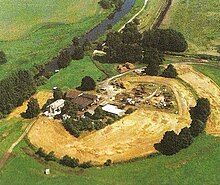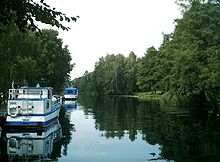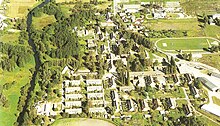Eggesin
| coat of arms | Germany map | |
|---|---|---|

|
Coordinates: 53 ° 41 ′ N , 14 ° 5 ′ E |
|
| Basic data | ||
| State : | Mecklenburg-Western Pomerania | |
| County : | Vorpommern-Greifswald | |
| Office : | At the Szczecin Lagoon | |
| Height : | 3 m above sea level NHN | |
| Area : | 88.01 km 2 | |
| Residents: | 4710 (Dec. 31, 2019) | |
| Population density : | 54 inhabitants per km 2 | |
| Postcodes : | 17367, 17375 (Hoppenwalde) |
|
| Area code : | 039779 | |
| License plate : | VG, ANK, GW, PW, SBG, UEM, WLG | |
| Community key : | 13 0 75 031 | |
| LOCODE : | DE EGQ | |
City administration address : |
Stettiner Strasse 1 17367 Eggesin |
|
| Website : | ||
| Mayor : | Dietmar Jesse ( CDU ) | |
| Location of the town of Eggesin in the Vorpommern-Greifswald district | ||
Eggesin [ ɛɡəˈziːn ] is a country town in the Vorpommern-Greifswald district in Mecklenburg-Vorpommern (Germany). Since December 31, 2004, Eggesin has been the administrative seat of the Am Stettiner Haff office , to which another twelve communities belong. The place is one of his surroundings basic center , located in the metropolitan area of the city of Szczecin . Eggesin only received town charter in 1966 , making it the youngest town in Mecklenburg-Western Pomerania.
geography
Geographical location
The city at the confluence of the rivers Uecker and Randow is located a few kilometers south of the city of Ueckermünde and forms the center of the chain of cities Ueckermünde - Eggesin - Torgelow, which extends for about 15 km along the Uecker. The border with the Republic of Poland runs in the east . Eggesin is located in the center of the Am Stettiner Haff nature park .
landscape
The landscape is characterized by the Ueckermünder Heide , it is flat and very wooded. In the north there are smaller lakes such as Bärenkamp or the Eggesiner See, which has silted up into a moor and is home to many animals and plants. Further to the northeast, the heather and meadow landscape condenses into high-standing beech and pine forests. To the east there is predominantly mixed forest with a high proportion of pine and sandy soils. South of Eggesin, the alluvial meadows of the Randow Valley, surrounded by dense mixed forest, open up. The landscape west of Eggesin is characterized by the two rivers Uecker and Randow as well as the wide meadow landscapes and fen areas . Behind it extends the pine forest typical of the region at the level of Torgelow-Holländerei .
City structure
The Hoppenwalde district belongs to Eggesin
Housing estates are:
- Eggesiner tar oven
- Gumnitz (Gumnitz Holl and Klein Gumnitz)
- Karpin
Neighboring communities
The following places border on Eggesin: Ueckermünde , Vogelsang-Warsin , Luckow , Ahlbeck , Hintersee , Viereck , Torgelow and Liepgarten (starting clockwise from the north).
history

Surname
Originally the Slavic village was called Gizin or Gizyn around 1216 , also Chyzin in 1267 . In 1296 the E was prefixed, and the place was now Egezyn and in 1302 Eksin . The old Polish name could be derived from house or earth hut . Another translation of Gizyn could mean confluence, which suggests the confluence of the Randow into the Uecker.
middle Ages
In 1216 Eggesin appeared for the first time in a document from the Dukes Bogislaw II and Casimir II of Pomerania, who donated the village ( villa ) Gizin from the then Rochow province to the Grobe monastery on Usedom . In 1241 the Camminer Bishop Konrad III confirmed. the monks their property in Eggesin. At the end of the 13th century the dorpe to Eksin came to the Jasenitz monastery . Around 1350, the Bavarian knight Zacharias Hase von Kufstein built the Neu Torgelow Castle on the Schlossberg near Eggesin, which today is only reminiscent of an elevation in the relief.
16th to 19th century
From the 16th century had stains immediate possession of the Dukes of Pomerania (to 1637). The Thirty Years War also affected Eggesin. In the Peace of Westphalia in 1648 Eggesin was added to Swedish Pomerania . In 1720 Eggesin became Prussian . After looting and pillage, only five farmers survived in the village after this war. The area around Eggesin was slowly repopulated with farmers, fishermen and woodcutters, charcoal burners and tar skaters. The half-timbered church in Eggesin was consecrated in 1731.
The first brick factory was built in 1818. In 1884 the place got a railway connection via the Jatznick – Ueckermünde line. The Eggesin volunteer fire brigade was founded in 1888. Around 1900, twelve brickworks, three sawmills, three windmills, an iron foundry, boat workshops and later a box factory ensured an economic upswing. From 1913 the community received the first electricity connections. In the period from 1840 to the 1960s barges were loaded with bricks and ore and up to Ueckermünde to the Szczecin Lagoon towed . From there, the coffee barges , which were only built for the lagoon and lagoon, sailed along the coast and sold the goods.
Recent history
Today's residential area Karl-Marx-Straße was created in 1936 as a residential camp for the employees of the newly established armaments company Luftmunitionsanstalt (MUNA) and Deutsche Sprengchemie GmbH with the cover name Seewerk .
After the Second World War , Eggesin began developing into a garrison town in 1952 with the stationing of units of the barracked People's Police , then the National People's Army ( 9th Panzer Division ). During the GDR era, Eggesin, like the neighboring Torgelow, was synonymous with the army for thousands of conscripts . The Bundeswehr closed the site until 2005. The Eggesin-Karpin artillery barracks was one of the largest barracks in the GDR. It was auctioned in 2019.
In the 1950s, facilities such as rural outpatient clinic , pharmacy, post office and polytechnic high school (POS) were established. On August 7, 1966, on the occasion of its 750th anniversary, Eggesin received city rights and its first city coat of arms. The electric motor factory started its work in 1971. In the 1970s and 1980s, 896 prefabricated buildings (Maternstrasse and Lindenstrasse), the multi-purpose town hall building and two new schools were built.
The closure of large parts of the barracks after 1990 resulted in a. a high unemployment rate; many young residents moved away. The high vacancy rate meant that entire rows of streets were demolished or dismantled and redesigned.
Since 1991, the historic city center has been thoroughly renovated as part of the urban development funding. A shopping center (Randow-Passage), the school and leisure center, a hotel, a medical center, a new landing stage on the Randow , the Karpin forest sports area, the Move sports and recreation center (now the befree sports center) and the district's vocational school were built Vorpommern-Greifswald. The half-timbered church and many houses in the city center were renovated, and new homes and terraced houses were built. For his exemplary urban planning cooperation with the cities of Ueckermünde and Torgelow , Eggesin was awarded in the federal competition " Urban Redevelopment East " in 2002.
After 2000 the new Randow Bridge was built and a new fire station was handed over. In 2007 the new town hall was inaugurated in the converted forester's house. The originally preserved four-sided courtyard of the forest building, together with the town hall, the blueberry barn as an event location, the Kulturwerk Vorpommern eV and the police station, form the new cultural and public center of the city. Eggesin has been the seat of the Am Stettiner Haff nature park administration since 2008 .
From 1952 to 1994 Eggesin belonged to the Ueckermünde district (until 1990 in the GDR - Neubrandenburg district , then in the state of Mecklenburg-Western Pomerania). In 1994 the city was incorporated into the Uecker-Randow district. Since the district reform in 2011 , it has been in the Vorpommern-Greifswald district .
Hoppenwalde district
Catholic settlers from the Palatinate founded Hoppenwalde in 1749. The predominantly Catholic faith still reminds of the Palatinate founders - every year the Corpus Christi festival takes place with a procession through Hoppenwalde. Today Hoppenwalde is a typical street village with a small dock on the Uecker. The local train stop was served until 2011.
Incorporations
On July 1, 1950, Hoppenrade was incorporated into Eggesin. After regaining independence on January 1, 1957, the place came back to Eggesin on August 14, 1992.
Population development
Eggesin has lost almost half of its inhabitants since 1990. This is due to the withdrawal of the German armed forces from Eggesin / Karpin and the unfavorable economic situation in the region.
|
|
|
|
from 1990: as of December 31 of the respective year
politics
City council
The city council consists of 17 members. The local elections on May 26, 2019 resulted in the following distribution of seats:
| Party / group of voters | 2014 | 2019 |
|---|---|---|
| CDU | 7th | 6th |
| Citizens' alliance with competence for Western Pomerania | - | 3 |
| The left | 4th | 3 |
| NPD | 2 | 2 |
| SPD | 1 | 2 |
| Individual applicant Rainer Kasch | 1 | 1 |
| Citizens' Alliance Uecker-Randow | 2 | - |
| All in all | 17th | 17th |
mayor
- since 2008: Dietmar Jesse (CDU)
Jesse was elected in the mayoral election on April 26, 2015, with 76.6% of the valid votes for a further term of seven years.
coat of arms
|
Blazon : "Argent, a blue bar rafters; accompanied below: by a tinned red wall trimmed on both sides with a closed golden gate and crenellated tower, raised by an erect, golden armored red griffin with a folded tail. "
The coat of arms was approved by the Ministry of the Interior on June 21, 1993 and registered under number 74 of the coat of arms of the state of Mecklenburg-Western Pomerania. |
|
| Justification of the coat of arms: The coat of arms, changed in 1993, combines a symbol with landscape reference points with an urban symbol and a symbol of power. While the herald's image, the rafter, is supposed to symbolize the confluence of the Randow on the Eggesiner district in the Uecker, the wall stands on the one hand as a symbol of the city, on the other hand it is intended to remind of the former brickworks, which dominated the economic development of the community Role played. The grasping is intended to refer to Eggesin's historical affiliation with Pomerania. |
flag
The flag was designed by Eggesiner Claus Weinmann and approved on October 22, 1996 by the Ministry of the Interior.
The flag is striped lengthways with blue, white, red, white and blue. The blue stripes each take up a ninth, the white stripes a little over a third and the red stripe an eighteenth of the height of the flag cloth. In the middle of the red stripe, at three quarters of the height of the two white stripes, there is the city arms. The relation of the height of the flag cloth to the length is like 3: 5.
Official seal
The official seal shows the city coat of arms with the inscription "STADT EGGESIN".
Partnerships
- City partnership with Złotów ( Poland )
- City friendship with Ennigerloh ( North Rhine-Westphalia )
- Partnership with the headquarters company of the 41st Panzer Grenadier Brigade
Sights and culture
Buildings
→ See also the list of architectural monuments in Eggesin
- Martin Luther Church, Protestant neo-Gothic brick church from 1911 with a 48 meter high tower
- Half-timbered church, built in 1731, today a local museum
- Old elementary school, today home parlor and registry office

nature
- Am Stettiner Haff Nature Park
- Eggesiner See nature reserve as a moor
Culture
- Military history and technical museum Eggesin
- Home parlor
- Kulturwerk Vorpommern with cinema events of the Association for Film Communication Mecklenburg-Vorpommern
- Blueberry barn under the direction of the Pro Eggesin association
- Cultural workshop under the direction of the Vorpommern cultural association
Economy and Infrastructure
Companies
- Hanning Elektro-Werke GmbH & Co. KG
- Greese Betonwaren GmbH
- Metal construction miner
traffic
Eggesin lies on the national roads L 28 ( Ueckermuende -Grenzübergang Hintersee to Poland) and L 32 (Eggesin- Torgelow ). The closest motorway junctions are Pasewalk-Nord and Pasewalk-Süd on the A 20 ( Rostock - Uckermark triangle ).
Eggesin station is on the Jatznick – Ueckermünde railway line . It is served by the regional express line RE 4 ( Pasewalk –Ueckermünde Stadthafen) every two hours and every hour during rush hour. The breakpoint in the Hoppenwalde district was closed in 2011.
education
- Primary school, Waldstrasse 20
- Regional school "Ernst Thälmann", Luckower Straße 6A
- Special educational support center, Lindenstr. 35
- Youth art school "Uecker-Randow", Luckower Str. 6B
- Vocational school , Lindenstrasse 35
Sports
- befree sports center
- Eggesin school and youth center
- Water hiking rest area on the Randow
societies
- SV Motor Eggesin
- Sports Association Eggesin 90
- Eggesiner equestrian club
- Eggesiner Rifle Club 91
- Water sports club blue-white
- Stock car club
- Hikers Lagoon Coast
The ASG Vorwärts Eggesin-Karpin existed from 1956 to 1989 .
Personalities
sons and daughters of the town
- Ludwig von Schröder (1854–1933), Admiral of the Imperial Navy
- Adolf Dresen (1935–2001), theater and opera director
- Egbert Swensson (* 1956), sailing enthusiast
Associated with Eggesin
- Julia Schoch (* 1974), writer, grew up in Eggesin
- Tino Müller (* 1978), politician (NPD), lives in Eggesin
Literature and film
- Walter Graupner, Gerd Mietzner: Eggesin - Small town in Western Pomerania. Steffen, Berlin 2000, ISBN 3-980534359 .
- Dietmar Materna: Cover name lake. Schibri, Berlin 2000, ISBN 3-933978300 .
- Edwin Kuna, Hannelore Kuna: Between Uecker and Randow. Historical town portraits . Maaß, Pasewalk 2002.
- Eggesin possibly. documentary
Web links
Individual evidence
- ↑ Statistisches Amt MV - population status of the districts, offices and municipalities 2019 (XLS file) (official population figures in the update of the 2011 census) ( help ).
- ↑ Regional Spatial Development Program Vorpommern (RREP) 2010 ( Memento of the original from September 24, 2015 in the Internet Archive ) Info: The archive link was inserted automatically and has not yet been checked. Please check the original and archive link according to the instructions and then remove this notice. - Central local structure with regional, medium and basic centers, accessed on July 12, 2015
- ↑ Main statute of the city of Eggesin, § 13
- ↑ a b Ernst Eichler and Werner Mühlmer: The names of the cities in Mecklenburg-Western Pomerania. Ingo Koch Verlag, Rostock, 2002, ISBN 3-935319-23-1
- ↑ a b Nordkurier of March 30, 2009; P. 27 "April Calendar"
- ^ Pomeranian document book . Volume 1. 2nd edition. Böhlau Verlag, Cologne and Vienna 1970, No. 170.
- ↑ Bundeswehr real estate in MV sold for around two million euros. in: Ostsee-Zeitung , December 1, 2019.
- ↑ Population development of the districts and municipalities in Mecklenburg-Western Pomerania (Statistical Report AI of the Statistical Office Mecklenburg-Western Pomerania)
- ^ Result of the local elections on May 25, 2014
- ^ Result of the local election on May 26, 2019
- ↑ Main statutes of the city of Eggesin, § 7
- ^ Result of the mayoral election on April 26, 2015
- ↑ Hans-Heinz Schütt: On shield and flag production office TINUS, Schwerin 2011, ISBN 978-3-9814380-0-0 , p. 407/408.
- ↑ a b Main Statute of the City of Eggesin, § 1 (PDF).
- ↑ Welcome to the website of the Kulturwerk Vorpommern e. V. Kulturwerk Vorpommern e. V., accessed on May 10, 2016 .
- ^ Eggesin possibly on www.filmdienst.de















